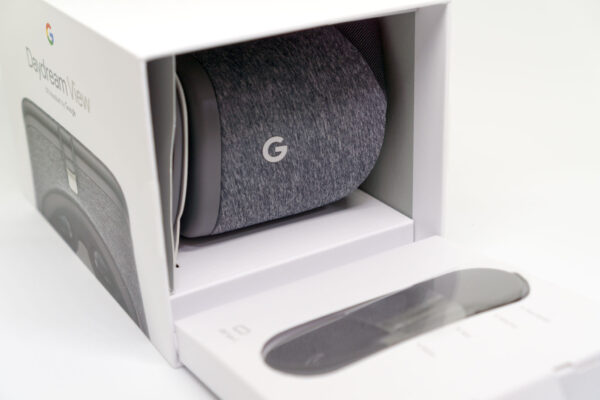
Virtual Reality (VR) headsets used to be very costly gadgets. Then, Google surprised us with their Google Cardboard in 2014. It was made with cardboard, and you could make it yourself. It brought VR to the masses. It was workable, but it wasn’t great. Last year, Google introduced Daydream View. It costs more, but still quite affordable.
Daydream View is the first headset designed for Google’s new Daydream VR platform. This was a little confusing for me at first, because Google also has something called “Daydream mode”, which is an interactive screensaver on Android devices. The new Daydream is a VR platform. The first VR headset for Daydream is the Daydream View. Initially, Daydream will only work for Google’s new Pixel and Pixel XL smartphones, though eventually we expect many other smartphones to be supported.
In many ways, the Daydream View is like the Cardboard in terms of look and design. A flip cover on the front opens up to slot in your smartphone. When closed, the cover holds the smartphone against the headset, in front of a pair of lens.
The difference is that the Daydream View is a properly made gadget. The plastic body is lined with soft fabric. There are three different colour choices for this fabric: Slate, Snow and Crimson (i.e. grey, white, and red).
While the Cardboard used velcro strips to hold the cover in place, the Daydream View uses an elastic band to hook on a catch at the top of the headset.
The Daydream View also comes with a handheld controller, which you can use for interaction with the VR apps. It’s mostly used like a laser pointer, allowing you to easily navigate menus and other controls in the VR space. But it’s also very much a motion stick, and like the Nintendo Wii-remote, you can use it to, say, throw objects in the VR scene.
The headset has clever capacitive stubs in the centre, which allows your smartphone to figure out its position in the headset.
The handheld controller features a trackpad, which on top of being the main selection button, can also support swiping gestures. There are two more buttons for App and Home. The App button depends on what app you’re running. There is also a volume rocker on the side.
I find the controller not just really useful, but also offers a lot more natural interaction with the VR scene. The old button slider thing on the Cardboard was inconvenient, and the buttons on, say, the Samsung Gear VR, wasn’t much better.
The fit and comfort of the Daydream View was a bit of a problem for me. It’s not uncomfortable per se. The issue is that it doesn’t seem to fit me right. The headset tends to fall downward. Perhaps it’s just me, my nose is too flat, so it doesn’t help hold the headset in position.
In this respect, I find that the Samsung Gear VR, which has an additional strap that goes over the head, is better able to holds its position correctly.
Unlike the Samsung Gear VR, the Daydream View doesn’t have a focusing ring. Instead, you adjust the headset with respect to your eyes so that the image is in focus. I suppose this works too. You can wear the Daydream VR over your glasses.
Apps and games are easy to download. There aren’t all that many, but no doubt there will be more to come. There are some games which make good use of the handheld controller. You can also watch YouTube in VR, Netflix VR, HBO Now VR, among others. The 360° videos are really cool and immersive.
Right now, Daydream View works only with the Pixel and Pixel XL. I tested with the Pixel XL, and the smartphone runs hot. Even while not doing really intensive scenes, like just browsing photos, the Pixel XL gets rather hot. Hopefully Google can do something about running Daydream more efficiently.
The Google Daydream View is available from the Google Store for US$79. Not yet available in Singapore, but I’m sure those determined souls will have no trouble getting their hands on this headset.
Conclusion
The Google Daydream View is an inexpensive VR headset. It’s handheld controller is really useful, providing natural interaction with VR scenes.
Pros:
- Inexpensive
- Useful handheld controller
Cons:
- Phone gets hot
- Your mileage may vary with the “fit”
